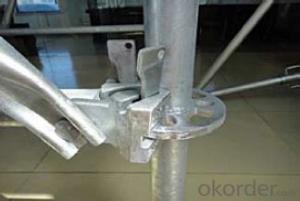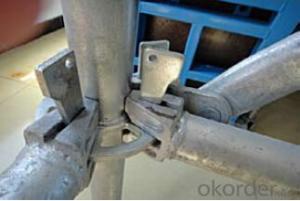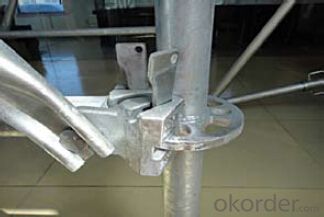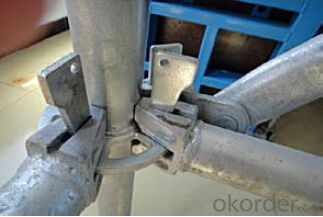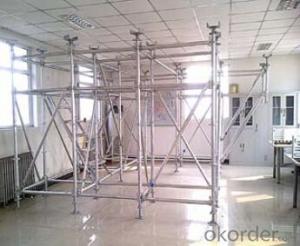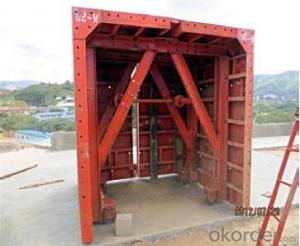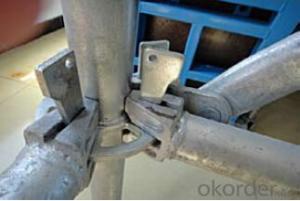Ring-Lock Scaffolding Accessories for scaffolding system
- Loading Port:
- Tianjin
- Payment Terms:
- TT OR LC
- Min Order Qty:
- 50 m²
- Supply Capability:
- 1000 m²/month
OKorder Service Pledge
Quality Product, Order Online Tracking, Timely Delivery
OKorder Financial Service
Credit Rating, Credit Services, Credit Purchasing
You Might Also Like
Ring-lock Scaffolding
A support system for construction, ownsadvantages of both cup-lock scaffolding andshoring tower.
It is in the development direction of new typescaffolding.
It is widely used in buildings, bridges, tunnels etc..
Characteristics:
◆ Easy to storage and transportation
◆ High degree of standardization
◆ Easy and quick erection
◆ Excellent stability and bearing capacity
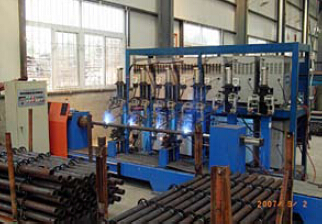

- Q: What are the considerations when designing steel formwork for swimming pools?
- When designing steel formwork for swimming pools, there are several key considerations that need to be taken into account. Firstly, the structural strength of the formwork is crucial as it needs to withstand the weight of the concrete and the water pressure once the pool is filled. The formwork should be made of high-quality steel that is able to support these loads without any deformation or failure. Additionally, the design should ensure proper alignment and support to achieve the desired shape and dimensions of the swimming pool. Attention should be given to the corners, curves, and transitions to ensure smooth and even concrete placement. The formwork should also allow for easy and efficient installation and removal. Considering the time and labor involved in constructing a swimming pool, a well-designed formwork system can greatly streamline the process and save on costs. Modular or adjustable formwork systems can be beneficial in this regard. Furthermore, the formwork should be able to withstand the chemical exposure from the pool water and any necessary maintenance or repairs. It should be resistant to corrosion and have a long lifespan to avoid frequent replacements. Lastly, safety measures should be incorporated into the design to protect workers during the construction phase. This can include features like sturdy handrails, non-slip surfaces, and proper access points. Overall, designing steel formwork for swimming pools requires careful consideration of structural integrity, ease of installation, durability, and safety to ensure a successful and long-lasting construction project.
- Q: Are there any environmental considerations when using steel formwork?
- Using steel formwork in construction projects raises several environmental considerations. First and foremost, the production of steel leaves a significant carbon footprint. Greenhouse gas emissions are generated during the extraction and processing of raw materials, such as iron ore and coal. Moreover, the manufacturing process itself requires a substantial amount of energy, further contributing to carbon emissions. In addition, the transportation of steel formwork systems has a negative environmental impact. The movement of heavy steel panels and other components increases fuel consumption and emissions, particularly for long distances. Furthermore, steel formwork is typically non-renewable and non-recyclable. Once it reaches the end of its useful life, it often ends up in landfills, contributing to waste accumulation and environmental pollution. However, it is important to note that steel formwork does have some environmental advantages compared to other materials. For instance, it can be reused multiple times, reducing the need for new materials and minimizing waste generation. Its durability and strength also contribute to a longer lifespan and less frequent replacements, which in turn reduces overall resource consumption. To mitigate the environmental impact of using steel formwork, various measures can be taken. These include optimizing transportation routes to reduce fuel consumption, implementing energy-efficient manufacturing processes, and promoting the recycling of steel formwork components at the end of their life. Additionally, exploring alternative formwork materials, such as recycled or sustainable options, can also help address the environmental considerations associated with steel formwork usage.
- Q: What are the different surface treatments available for steel formwork panels?
- There are several surface treatments available for steel formwork panels to enhance their durability and performance. Some of the common surface treatments include: 1. Galvanization: This involves immersing the steel formwork panels in a bath of molten zinc, which forms a protective layer on the surface. Galvanization provides excellent corrosion resistance, making the panels suitable for use in outdoor and highly corrosive environments. 2. Powder coating: This process involves applying a dry powder coating to the steel surface and then curing it under heat. Powder coating provides a durable and attractive finish, offering resistance to corrosion, abrasion, and chemicals. It also allows for a wide range of colors and textures. 3. Epoxy coating: Epoxy coatings are applied to the steel surface as a liquid and then cured to form a hard and protective layer. This surface treatment provides excellent resistance to corrosion, chemicals, and abrasion. Epoxy coatings are commonly used in environments where the formwork panels are exposed to harsh conditions. 4. Paint: Steel formwork panels can also be painted with various types of paint to provide a protective layer and improve aesthetics. Paints can offer resistance to corrosion, UV radiation, and wear, depending on the type and quality of the paint used. 5. Shot blasting: This treatment involves the use of high-speed steel shot or grit particles to blast the surface of the steel formwork panels. Shot blasting removes any rust, scale, or contaminants from the surface, providing a clean and roughened profile for better adhesion of subsequent coatings. 6. Hot-dip aluminizing: This process involves immersing the steel formwork panels in a bath of molten aluminum. It forms a thin layer of aluminum on the surface, providing excellent corrosion resistance and heat reflectivity. These different surface treatments for steel formwork panels offer varying levels of protection against corrosion, abrasion, chemicals, and other environmental factors. The choice of surface treatment depends on the specific application and the level of durability required.
- Q: What are the different types of corner solutions available for steel formwork?
- There are several different types of corner solutions available for steel formwork, each with its own advantages and applications. 1. External Corner Solutions: These are typically L-shaped or angled brackets that are used to form external corners in concrete structures. They are easy to install and provide a clean and sharp finish to the corners. External corner solutions are commonly used in building construction, especially for walls and columns. 2. Internal Corner Solutions: Similar to external corner solutions, internal corner solutions are used to form internal corners in concrete structures. They can be either L-shaped or U-shaped brackets, depending on the specific requirements. Internal corner solutions are commonly used in the construction of walls, slabs, and beams. 3. Adjustable Corner Solutions: These are versatile corner solutions that allow for adjustable angles and dimensions. They are designed to accommodate various corner configurations, making them suitable for complex structures or irregular shapes. Adjustable corner solutions are often used in the construction of curved walls, circular columns, and other unique architectural features. 4. Hinged Corner Solutions: Hinged corner solutions are specialized brackets that allow for easy removal of formwork after the concrete has cured. They feature hinges that enable the formwork to be opened and closed, providing quick and efficient access to the concrete surface. Hinged corner solutions are commonly used in applications where frequent access to the concrete surface is required, such as in tunnels or underground structures. 5. Reinforced Corner Solutions: These corner solutions are specifically designed to provide additional strength and support to the corners of concrete structures. They are reinforced with steel bars or plates to enhance the structural integrity and durability of the formwork. Reinforced corner solutions are commonly used in high-rise buildings, bridges, and other heavy-duty structures. Overall, the choice of corner solution depends on the specific requirements of the construction project, including the desired finish, structural integrity, and ease of installation and removal. It is important to consider these factors and consult with a structural engineer or formwork specialist to determine the most suitable corner solution for a particular application.
- Q: How does steel formwork handle complex geometries?
- Steel formwork is highly versatile and can easily handle complex geometries in construction projects. Unlike traditional wooden formwork, steel formwork is custom-designed and fabricated to meet the specific requirements of the project, allowing for intricate and complex shapes to be formed. Steel formwork is constructed using modular components that can be assembled and adjusted to accommodate various geometric configurations. This flexibility enables it to handle complex shapes such as curves, arches, and irregular structures, which would be difficult to achieve with other types of formwork. Additionally, steel formwork offers superior strength and stability, allowing it to withstand the pressure exerted by the concrete during pouring and curing. This strength allows for the construction of tall and complex structures without compromising the integrity of the formwork system. Moreover, steel formwork can be easily reused multiple times, making it a cost-effective solution for handling complex geometries. Its durability and resistance to wear and tear ensure that it can be used for numerous projects, further enhancing its economic viability. Steel formwork also provides a smooth and consistent finish to the concrete surface, resulting in high-quality end products. This is particularly important when dealing with complex geometries, as any imperfections or inconsistencies could be more pronounced and visible. Overall, steel formwork is a reliable and efficient solution for handling complex geometries in construction. Its versatility, strength, reusability, and ability to provide a smooth finish make it an ideal choice for projects with intricate and challenging shapes.
- Q: Can steel formwork be used for industrial structures?
- Indeed, steel formwork proves to be a viable option for constructing industrial structures. This method involves utilizing steel panels or sheets to establish temporary molds or frameworks, which then hold and shape the concrete throughout the construction process. The utilization of steel formwork is particularly favored in industrial construction due to its robustness, durability, and capacity to endure heavy loads and high pressures. The construction of industrial structures often necessitates formwork systems that can withstand the weight of substantial concrete pours and provide ample support during the curing phase. Steel formwork showcases these qualities, rendering it an ideal selection for industrial projects. Furthermore, steel formwork guarantees exceptional dimensional accuracy, ultimately ensuring precise and consistent outcomes in the construction of industrial structures. Additionally, it can be easily adjusted and reused, leading to cost savings and improved efficiency throughout the construction process. Another notable advantage of steel formwork lies in its ability to withstand adverse weather conditions and extreme temperatures, thus rendering it suitable for a diverse range of industrial settings. Its resistance to warping, cracking, and other forms of damage ultimately safeguards the structure's integrity and longevity. Moreover, steel formwork can be customized to meet the specific requirements of various industrial structures, thereby allowing for flexibility in design and construction. Its ease of assembly and disassembly facilitates faster construction cycles and reduces overall project timelines. To conclude, steel formwork emerges as an exceedingly suitable choice for industrial structures due to its strength, durability, dimensional accuracy, weather resistance, and flexibility. The numerous advantages it offers over alternative formwork materials position it as the preferred option within the construction industry.
- Q: Can steel formwork be used for swimming pool construction?
- Swimming pool construction can utilize steel formwork, which is a versatile and durable choice commonly employed in the construction industry for various purposes. Steel formwork offers numerous benefits, such as high strength, stability, and reusability, making it ideal for constructing swimming pool walls, floors, and other structures. By employing steel formwork, a smooth and precise finish is achieved, ensuring uniformity in the appearance of swimming pool walls and floors. It can withstand the water pressure, ensuring the structural integrity of the pool. Furthermore, steel formwork is easily assembled and disassembled, facilitating efficient construction and maintenance. Additionally, steel formwork is highly adaptable and can be customized to meet specific design requirements. It accommodates the construction of various shapes and sizes of swimming pools, including both in-ground and above-ground options. This adaptability makes steel formwork the preferred choice for swimming pool construction projects. Nevertheless, when employing steel formwork for swimming pool construction, certain factors must be considered. Proper waterproofing measures must be implemented to prevent water leakage and corrosion of the steel. Adequate reinforcement and support are also necessary to ensure the stability and durability of the pool structure. In conclusion, steel formwork is a suitable option for swimming pool construction due to its strength, durability, and versatility. Proper usage, in combination with appropriate waterproofing and reinforcement measures, can result in a robust and visually pleasing swimming pool.
- Q: What are the typical lead times for manufacturing steel formwork?
- The typical lead times for manufacturing steel formwork can vary depending on factors such as the complexity of the design, the quantity required, and the current workload of the manufacturer. However, on average, lead times for manufacturing steel formwork can range from a few weeks to a few months.
- Q: How does steel formwork affect the overall construction site aesthetics?
- Steel formwork can greatly enhance the overall aesthetics of a construction site. Its sleek and modern appearance gives a professional look to the project, creating a sense of organization and efficiency. Steel formwork's clean lines and smooth finishes provide a visually pleasing backdrop for the construction process, improving the overall visual appeal of the site. Additionally, its durability and ability to create precise and intricate designs contribute to a more refined and sophisticated aesthetic outcome.
- Q: Are there any specific building codes or regulations related to steel formwork?
- Yes, there are specific building codes and regulations related to steel formwork. These codes and regulations vary by country and region, but they generally cover aspects such as design, construction, installation, and safety requirements for steel formwork systems. These regulations ensure that steel formwork structures meet the necessary standards for strength, stability, and durability, while also addressing issues such as fire resistance, load capacity, and worker safety. Compliance with these codes and regulations is crucial to ensure the successful and safe use of steel formwork in construction projects.
Send your message to us
Ring-Lock Scaffolding Accessories for scaffolding system
- Loading Port:
- Tianjin
- Payment Terms:
- TT OR LC
- Min Order Qty:
- 50 m²
- Supply Capability:
- 1000 m²/month
OKorder Service Pledge
Quality Product, Order Online Tracking, Timely Delivery
OKorder Financial Service
Credit Rating, Credit Services, Credit Purchasing
Similar products
Hot products
Hot Searches
Related keywords
